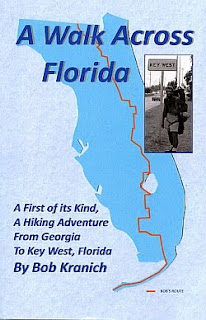As I sat my pack down near the road to look around, a VW van came by with a bunch of real hippies in it, hollering,
“Hey need a ride?” I waved them on.
I looked around the bridge abutment. It had the original railroad foundations and railroad track being used for a railing. I was inspecting all this on both sides of the highway,….
….In length, this bridge was the big one. Here I am sitting on Knights Key. In 1908 it was the end of the line, with a dock built far out in the water for ocean steamships to load passengers and freight heading to Key West, Cuba and even the Panama Canal. It took two years to build these facilities and was finished and available for regular service in February of 1908. This dock had a post office, hotel and custom’s office. It could handle two complete trains at one time and the Flagler steamships. These facilities were used until the rest of the bridges and line were completed to Key West in January of 1912.
The seven mile bridge construction was divided into 4 parts. These were Knights Key, Pigeon Key, Moser Channel and Pacet Channel bridges. Knights, Pigeon, and Moser were steel-girder spans on top of vertical concrete foundation piers. Some of the foundations were 28 feet below the waterline. These spans were formally called deck plates and were mostly 80 feet long. In the center of the Moser Channel section was a 253-foot swinging steel truss bridge for Atlantic to the Gulf ship traffic. The Pacet Channel bridge was a series of 210 spandrel arches similar to the Long Key viaduct I had just crossed. The seven-mile bridge took two years to build.
One of the main work camps was Pigeon Key which was about one mile out from Knights Key. Its facilities took care of 400 workers during the bridge construction between 1908 and 1912. Today many of the original work camp buildings are preserved, open to public and administered by the Pigeon Key Foundation and Marine Science Center. One can go out to them by walking or biking on the old bridge or by boat.
As I sat there looking out, I could see the vertical concrete bridge piers heading out to Pigeon Key. The steel girder spans were on top of these piers, and the water pipe was attached to the side of the girders. It was installed by the U. S. Navy in 1941. The only water in the Keys was from rain. That rain was collected from the metal roofs of houses and buildings and channeled to storage areas. These storage areas were called cisterns and were usually made of reinforced concrete or metal. Even the early Indians stored water in open wells. During and after the railroad was being built, water was hauled to the Keys in tank cars. When the Navy installed the pipeline the Florida Keys Aqueduct Commission paid one-third of the expenses.
Enough of this sitting, I decided. I might as well get on with it, another hitch-hike. After all, if it was too dangerous to walk the one and two mile Long Key bridges, seven miles was out of the question!
I stuck my thumb out and the next vehicle stopped. It was a couple of boys in a VW car, and this time I made sure I said,
“Thanks guys, I only need a ride across this seven-mile bridge.”
As we were crossing, three girls in a red sports car convertible came up alongside. That meant they were passing us on this narrow two-lane bridge. The guys and girls started talking and they said something about pulling off on the other side of the bridge. That was good for my request, and before I knew it we were on the other side. They pulled up right behind the girls’ convert’, got out, and sprinted right over. I pulled my pack out of the back, hollered thanks to a couple of guys who were obviously distracted, and went on my way.
About the Author: After getting out of the Army Bob Kranich backpacked from the Georgia border to Key West in a 40 day adventure walk across Florida. His recently published book A Walk Across Florida is available from his website or Amazon.com

No comments:
Post a Comment